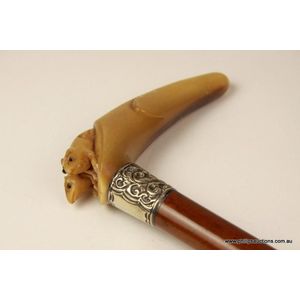Champleve Enamelled Gilt Bronze Symbolic Altar Offering
A Chinese champleve enamelled gilt bronze Symbolic offering, Qianlong (1735-1796) or Jiaqing (1796-1820) period, the symbolic altar offering cast in gilt bronze with champleve enamel details, of one of the seven Regal Buddhist symbols, the Queen, here depicted kneeling, her hands before her in anjalimudra, on an elaborate triple-lotus base in Qianlong rococo style, with champleve enamel details, which sits atop a pedestal featuring the character 'Shou', surrounded by four champleve enamel leaves, which in turn sit above an enamelled cosmic ocean, enclosed within a ruyi-motif pierced gallery border above a double lotus base., 37 cm high, 10 cm wide. Provenance: Soo Tze Oriental Antiques, 1999. Literature: for similar pieces please see: a special exhibition of Buddhist gilt votive objects, National Palace Museum, catalogue 22-5, 23-5, 25-5, 26 and 28. And Buddhist Art from Rehol, Jeff Hsu's Oriental Art, 1999, plate 69. Other Notes: Judging from the style of the image, and the quality of the casting and gilding and champleve enamel work, and specifically the style of the lotus base, this work is probably from one of the Imperial temples in Beijing.
You must be a subscriber, and be logged in to view price and dealer details.
Subscribe Now to view actual auction price for this item
When you subscribe, you have the option of setting the currency in which to display prices to $Au, $US, $NZ or Stg.
This item has been sold, and the description, image and price are for reference purposes only.
- Manner of .... / Style of ..... - A cataloguing term where the item, in the opinion of the cataloguer is a work in the style of the artist, craftsman or designer, possibly of a later period.
- Bronze - An alloy of copper and tin, traditionally in the proportions of about 9 parts of copper to 1 part of tin.
The discovery of bronze in Western Asia in the 4th century enabled people to create metal objects which were superior to those previoulsy possible because of its strength and hardness, and it has been used throughout the world for weapons, coins, tools, statuary and other decorative items.
It is very fluid in a molten state, and its hardness, strength when set, and non-corrosive properties makes it most suitable for casting sculpture. - Gilding - Gilding is a method of ornamentation whereby a thin sheet of gold metal is applied to items made of wood, leather, ceramics, glass and silver for decorative purposes.
For furniture including mirrors, the sheet of gold is usually applied over a coating of gesso. Gesso is a mixture of plaster of Paris and gypsum mixed with water and then applied to the carved wooden frames of mirrors and picture frames as a base for applying the gold leaf. After numerous coats of gesso have been applied, allowed to dry and then sanded a coat of "bole", a usually red coloured mixture of clay and glue is brushed on and allowed to dry, after which the gold leaf is applied. Over time parts of the gilding will rub off so the base colour can be seen. In water gilding, this was generally a blue colour, while in oil gilding, the under layer was often yellow. In Victorian times, gilders frequently used red as a pigment beneath the gold leaf.
Metal was often gilded by a process known as fire gilding. Gold mixed with mercury was applied and heated, causing the mercury to evaporate, the long-term effect of which was to kill or disable the craftsman or woman from mercury poisoning. The pursuit of beauty has claimed many victims, not the least of which were the artists who made those pieces so highly sought after today.
This item has been included into following indexes:
Visually similar items

Vintage timber bench seat, with mortised joints, 144 cm long approx.
Sold by
in
for
You can display prices in $Au, $US, $NZ or Stg.

Oil on canvas, unsigned, depicting castle by the lake, in gilded frame, approx 29 cm x 45 cm
Sold by
in
for
You can display prices in $Au, $US, $NZ or Stg.

Sold by
in
for
You can display prices in $Au, $US, $NZ or Stg.

A Victorian horn and silver walking cane, 1888 Birmingham, with maker's mark WM, the tapering malacca cane shaft with a scrolled silver ferrule surmounted by a cream brown mottled bone handle well carved with a pair of mice; hallmarked. Length 85 cm
Sold by
in
for
You can display prices in $Au, $US, $NZ or Stg.
